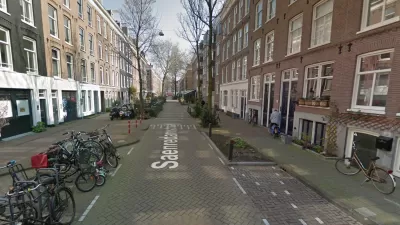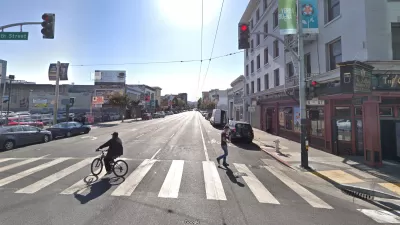Amsterdam will pursue the Oslo model of targeting parking spots, rather than driving bans, to make for a walk-and-bike friendly city. On-street parking spaces will gradually be replaced, starting July 1, with bike lanes, sidewalks, and trees.

Amsterdam isn't targeting actual parking spaces, but rather parking permits, required by motorists to park motor vehicles on the streets. Amsterdam will reduce parking permits in a new program that "strives for an accessible and livable city." Permits will also become more expensive.
"Amsterdam [deputy mayor] and transit commissioner Sharon Dijksma announced [March 28] that starting this summer, the city plans to reduce the number of people permitted to park in the city core by around 1,500 per year," reports Feargus O'Sullivan, who covers Europe for CityLab.
These people already require a permit to access a specific space (and the cost for that permit will also rise), and so by reducing these permits steadily in number, the city will also remove up to 11,200 parking spaces from its streets by the end of 2025.
The cleared spaces won’t be left empty, however. As room for cars is removed, it will be replaced by trees, bike parking, and wider sidewalks, allowing Amsterdammers to instantly see and feel the benefits of what will still be a fairly controversial policy among drivers.
Off-street parking won't be subject to the new program. In fact, new residents who apply for parking permits will be encouraged to find spaces in garages. "In total, there are 432,000 parking places in Amsterdam, of which 265,000 on the street and 167,000 in garages," according to Het Parool, an Amsterdam-based daily newspaper.
Existing residents need not fear to have their parking permits revoked, assuming they don't change residences. Instead, "the city will simply not replace any that are given up when drivers leave the city, give up their cars, or die," adds O'Sullivan. "In this way, the city reckons it can naturally do away with about 1,100 permits a year."
Currently, there are minimal wait periods for parking permits, writes Ruben Koops for Het Parool, "but due to the contraction, the waiting list will grow rapidly."
"The car remains part of this city, but its place is getting smaller," says Dijksma.
The parking permit reduction program is the result of the changes to the political landscape. "The city is currently being run by a coalition of left and centrist parties in which the Green Left party (GroenLinks) has the largest share," explains O'Sullivan. "A promise to reduce parking space formed part of the initial coalition agreement."
It also helps that elimination of parking spaces along the city's numerous canals brings major infrastructure benefits, adds O'Sullivan.
Many of the waterside streets and harbor quaysides in inner Amsterdam are in need of repair and renovation. Thanks to the delicate nature of Amsterdam’s subsoil, some of them actually need it pretty badly after groaning and buckling under the weight of cars for years.
"In the long term, Dijksma hopes that one of the major canals can be made car-free," adds Koops.
The Oslo approach
Jonathan Wolfe of The New York Times chronicled the shift in the car-free movement in Oslo, the capital and most populous city of Norway, from driving bans and toward parking removal, in addition to other strategies, posted here by Camille Fink on Dec. 25, 2018. See additional posts in Planetizen:
-
What Happens When a Downtown Becomes Nearly Car-Free? January 28, 2019
-
A Car Ban By Other Means, July 2, 2018
-
Oslo's Car-Free Dreams Easier Said Than Done, June 17, 2017
-
Pro-Walking, or Anti-Car? December 6, 2015
FULL STORY: A Modest Proposal to Eliminate 11,000 Urban Parking Spots

Alabama: Trump Terminates Settlements for Black Communities Harmed By Raw Sewage
Trump deemed the landmark civil rights agreement “illegal DEI and environmental justice policy.”

Planetizen Federal Action Tracker
A weekly monitor of how Trump’s orders and actions are impacting planners and planning in America.

How Atlanta Built 7,000 Housing Units in 3 Years
The city’s comprehensive, neighborhood-focused housing strategy focuses on identifying properties and land that can be repurposed for housing and encouraging development in underserved neighborhoods.

In Both Crashes and Crime, Public Transportation is Far Safer than Driving
Contrary to popular assumptions, public transportation has far lower crash and crime rates than automobile travel. For safer communities, improve and encourage transit travel.

Report: Zoning Reforms Should Complement Nashville’s Ambitious Transit Plan
Without reform, restrictive zoning codes will limit the impact of the city’s planned transit expansion and could exclude some of the residents who depend on transit the most.

Judge Orders Release of Frozen IRA, IIJA Funding
The decision is a victory for environmental groups who charged that freezing funds for critical infrastructure and disaster response programs caused “real and irreparable harm” to communities.
Urban Design for Planners 1: Software Tools
This six-course series explores essential urban design concepts using open source software and equips planners with the tools they need to participate fully in the urban design process.
Planning for Universal Design
Learn the tools for implementing Universal Design in planning regulations.
Caltrans
Smith Gee Studio
Institute for Housing and Urban Development Studies (IHS)
City of Grandview
Harvard GSD Executive Education
Toledo-Lucas County Plan Commissions
Salt Lake City
NYU Wagner Graduate School of Public Service




























